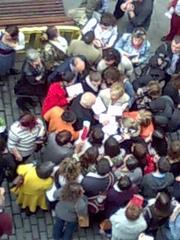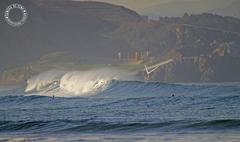Visiting Hours and Tickets for Museo de la Historia Urbana de Avilés, Avilés Historical Sites
Publication Date: 25/07/2024
Introduction to Museo de la Historia Urbana de Avilés
Nestled in the heart of Avilés, Asturias, Spain, the Museo de la Historia Urbana de Avilés stands as a beacon of cultural and historical enlightenment. Located at Calle La Ferrería, 35, this museum offers a detailed chronicle of the town’s evolution from its medieval beginnings to its industrial era. The museum’s narrative is deeply intertwined with the town’s significant milestones, such as the granting of the charter by King Alfonso VI in 1085, known as “El fuero,” which marked the formal establishment of Avilés (Wikipedia).
Visitors are treated to an immersive experience as they traverse the museum’s three floors, each dedicated to different historical periods and themes. From the medieval charters and documents on the third floor to the industrial advancements on the first floor, the museum offers a comprehensive exploration of Avilés’ rich heritage (WhichMuseum). Additionally, the museum’s strategic location amidst notable landmarks like the Padres Franciscanos Church and its emphasis on interactive and educational elements make it an ideal destination for history enthusiasts and curious travelers alike (Avilés Official Website).
Table of Contents
- Introduction
- History and Significance
- Thematic Areas and Exhibits
- Significance of the Estuary
- Architectural and Cultural Heritage
- Interactive and Educational Elements
- Accessibility and Visitor Information
- Nearby Attractions
- FAQ
- Conclusion
History and Significance
Historical Context
The Museo de la Historia Urbana de Avilés, located in the medieval town center of Avilés, is a significant cultural institution dedicated to chronicling the rich history of the city. The museum’s narrative begins with the granting of the charter by King Alfonso VI in 1085, a pivotal moment that marked the formal establishment of Avilés as a recognized urban entity. This charter, known as “El fuero,” laid the foundation for the town’s legal and administrative framework, fostering its growth as a commercial and maritime hub (Wikipedia).
Thematic Areas and Exhibits
The museum’s exhibition space spans approximately 1000 m² across three floors, each dedicated to different historical periods and themes. The layout guides visitors from the top floor down to the ground floor, providing a chronological journey through Avilés’ history (WhichMuseum).
Third Floor - The Charter and Medieval Beginnings
The third floor focuses on the early history of Avilés, particularly the period surrounding the granting of the charter by King Alfonso VI. This section includes artifacts discovered during archaeological excavations, offering insights into the town’s medieval origins. Interactive displays and original objects help visitors understand the significance of “El fuero” and its impact on the town’s development (Wikipedia).
Second Floor - Medieval Splendor
The second floor delves into the medieval era, highlighting the town’s growth and prosperity following the charter’s confirmation by Alfonso VII, the grandson of Alfonso VI, seventy years later. This period saw Avilés become a bustling urban and commercial center, with its port serving as a crucial link for trade with Oviedo and León. The exhibits on this floor showcase the architectural and urban advancements of the time, including the construction of imposing palaces and other significant buildings (Avilés Official Website).
First Floor - Trade with America and Industrialization
The first floor explores the town’s evolution during the Age of Exploration and the subsequent industrial era. This section highlights Avilés’ role in transatlantic trade, particularly its connections with the Americas. The arrival of industry in the town is also documented, illustrating how these developments transformed Avilés into a modern urban center. The exhibits include original objects and replicas that depict the town’s economic and social changes during these periods (Wikipedia).
Significance of the Estuary
A unique aspect of the museum is its emphasis on the estuary, which serves as the backbone of the exhibition. The estuary has played a fundamental role in the town’s history, acting as a vital conduit for trade and communication. The museum’s design incorporates views of the estuary, allowing visitors to appreciate its historical and contemporary significance (WhichMuseum).
Architectural and Cultural Heritage
The Museo de la Historia Urbana de Avilés is situated in a historic-artistic complex, surrounded by notable architectural landmarks. One of the most prominent is the Padres Franciscanos Church, the oldest building in Avilés, which stands opposite the museum. This church, originally the first parish church of the town, now serves as a convent for the Franciscan Fathers. The museum’s location in the heart of the historic center underscores its role in preserving and interpreting the town’s rich architectural and cultural heritage (Avilés Official Website).
Interactive and Educational Elements
The museum is designed to be highly interactive, making it an engaging and educational experience for visitors of all ages. Interactive resources, multimedia displays, and recreations are used throughout the museum to bring the history of Avilés to life. These elements are particularly beneficial for younger visitors, making the museum an ideal destination for families and school groups (Planaje).
Accessibility and Visitor Information
The Museo de la Historia Urbana de Avilés is accessible to a wide audience, with information available in Spanish, English, and Braille. The museum offers free admission, making it an attractive option for both locals and tourists. Guided tours are available for groups by prior arrangement, providing an in-depth exploration of the museum’s exhibits and the history of Avilés (Avilés Official Website).
Visitor Tips
To make the most of a visit to the Museo de la Historia Urbana de Avilés, it is recommended to allocate between 45 minutes to 1.5 hours, depending on the level of interest and the number of visitors. The museum’s visiting hours are from Tuesday to Friday, 10:30 AM to 1:30 PM and 4:00 PM to 8:00 PM, on Saturdays from 11:00 AM to 1:30 PM and 4:00 PM to 8:00 PM, and on Sundays and holidays from 11:00 AM to 1:30 PM. The museum is closed on Mondays (Planaje).
Nearby Attractions
The museum’s central location makes it a convenient starting point for exploring other attractions in Avilés. Nearby points of interest include the Oscar Niemeyer International Cultural Centre, a modern architectural landmark designed by the renowned Brazilian architect, and the Parque de Ferrera, a beautiful urban park. The proximity of these sites allows visitors to experience both the historical and contemporary facets of Avilés (Planaje).
FAQ
Q: What are the visiting hours of the Museo de la Historia Urbana de Avilés?
A: The museum is open from Tuesday to Friday, 10:30 AM to 1:30 PM and 4:00 PM to 8:00 PM, on Saturdays from 11:00 AM to 1:30 PM and 4:00 PM to 8:00 PM, and on Sundays and holidays from 11:00 AM to 1:30 PM. The museum is closed on Mondays.
Q: Is there an admission fee for the museum?
A: No, the museum offers free admission to all visitors.
Q: Can I book a guided tour?
A: Yes, guided tours are available for groups by prior arrangement.
Q: What languages are the exhibits available in?
A: Information is available in Spanish, English, and Braille.
Q: Are there any nearby attractions to visit after the museum?
A: Yes, nearby attractions include the Oscar Niemeyer International Cultural Centre and the Parque de Ferrera.
Conclusion
The Museo de la Historia Urbana de Avilés offers a comprehensive and engaging exploration of the town’s history, from its medieval origins to its industrial advancements. With its interactive exhibits, accessible design, and central location, the museum is a must-visit for anyone interested in the rich cultural heritage of Avilés. Plan your visit today to discover the fascinating history of this remarkable town.
References
- Wikipedia (n.d.). Museum of Avilés Urban History. Retrieved from https://en.wikipedia.org/wiki/Museum_of_Avilés_Urban_History
- WhichMuseum (n.d.). Museum of Aviles Urban History. Retrieved from https://whichmuseum.com/museum/museum-of-aviles-urban-history-32760
- Avilés Official Website (n.d.). Museo de la Historia Urbana de Avilés. Retrieved from https://aviles.es/mhua
- Planaje (n.d.). Guía del Museo de la Historia Urbana de Avilés. Retrieved from https://planaje.com/europa/espana/asturias/aviles/guia-museo-de-la-historia-urbana-de-aviles/

